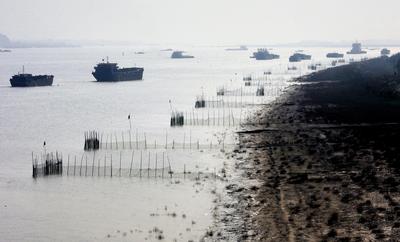This trend clearly indicates the strength of China’s marine economic strategies within its 12th Five-Year Plan. But with increasing regional competition for marine spaces and shipping lanes, these strategies are bound to impact the international community — and especially the littoral states of the regional seas.
China’s marine-economy initiative is an important part of its strategic reorientation from a traditional export-driven economy, which depends more on hinterland resources. The 2008 global financial crisis accelerated this change in strategy, a change that has since been driven by China’s stimulus packages. The rising inter-provincial competition for more coastal development spaces and preferential policies also act as strong local forces driving the strategy.
China has seen its centres of economic activity shift from the hinterland to coastal regions during its 2000-year history, with coastal economies attaining considerable prosperity during the early Tang and Ming dynasties. The opening of the maritime silk route, as well as frequent maritime trade with Northeast and Southeast Asian countries, generated steady development in China’s coastal regions over the centuries.
Today, the Tumen River Area Development Project (TRADP) is a typical example of multinational cross-border and cross-sea cooperation which has been in play since the early 1990s. It involves three countries linked by the Tumen River — Russia, China and North Korea — as well as South Korea and Mongolia. The experiences of TRADP are of great value for similar projects requiring international cooperation — even though the initiative did not fully realise its initial UNDP-conceived goal of pushing forward Tuman River Triangle cross-border cooperation.
The Guangxi Beibu Bay Economic Zone Development Plan, in operation since the late 1990s, is another ongoing case of cooperation with Southeast Asian countries, namely, Brunei, Indonesia, Malaysia, Singapore and the Philippines. Under the jurisdiction of the Guangxi Zhuang Autonomous Region’s local government, this project is designed to create a regional hub for trade, logistics, processing and manufacturing activities aimed at promoting economic cooperation with surrounding areas.
As China’s first national-level marine economic-development strategy, the Shandong Peninsula Blue Economic Zone has improved cross-sea cooperation with South Korea’s western coastal region. The plan for the project’s first phase comprises the construction of a pilot region for the China-ROK Free Trade Area and a train ferry program.
Zhejiang Province, as the second national-level marine economic zone, takes pride in its human-capital endowments. It also enjoys the privileges of its first national-level oceanic economy district, the Zhoushan Archipelago New Area. With its competitive location adjacent to the Yangtze River Delta, Zhoushan has established steady relations with many overseas partners. Singapore ranked as its second-largest investor in early 2011, for example, with 17 projects in Zhoushan valued at US$215 million. These projects involve marine engineering, ship repairs, ship industrial services, information consultation and tourism development.
And with the implementation of the China-ASEAN FTA, Guangdong gains an edge in facilitating cross-sea cooperation with ASEAN member states, and is expected to achieve far greater success than Shandong and Zhejiang. Guangdong is establishing a trade and economics office in Singapore to help its companies expand their businesses in Southeast Asia. Guangdong’s marine economic strategy will undoubtedly result in bigger business opportunities with ASEAN members, ranging from processing industries and marine tourism to maritime logistics services — and this is a significant step for the province.
China needs to revamp its traditional economic model, which is characterised by extensive utilisation of marine resources and spaces, irrational competition among coastal provinces over developing traditional marine industries, and the rampant establishment of container terminals. This demands a shift to a blue economy that values the management and conservation of marine resources.
In particular, the practice of attracting FDI by means of extensive land reclamation in the coastal zones should be rectified. And the capacity of specific ecosystems to withstand marine and coastal projects must be carefully appraised before these ventures are presented to overseas investors. Greater international cooperation is needed among marine and maritime organisations or clusters, marine research parks and overseas coastal regions to employ marine economic strategies more effectively. More attention should also be paid to offshore activities’ harmful impacts on the environment. Some experts from neighbouring countries like South Korea have expressed concern over increased contamination and deterioration in the Yellow Sea as a result of offshore activities. As such, efforts in monitoring and tackling potential threats in the regional seas should be reinforced.
Liu Shuguang is Professor of Marine Development at the Ocean University of China and a Visiting Senior Fellow at the S. Rajaratnam School of International Studies (RSIS), Nanyang Technological University.
A version of this article originally appeared here as RSIS Commentary No. 154/2011.

